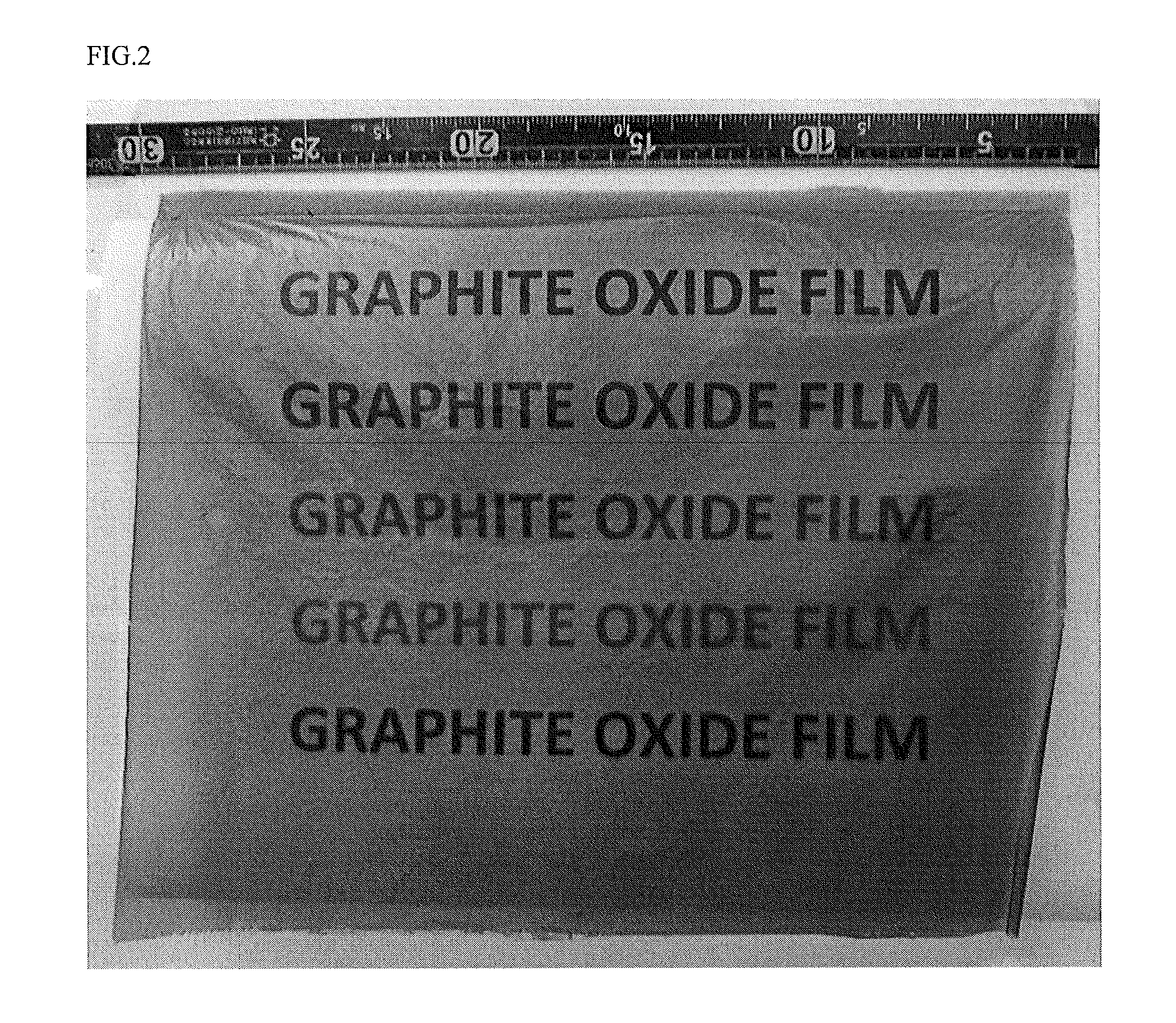Method for preparing graphene oxide films and fibers
a graphene oxide and fiber technology, applied in the field of large area graphene oxide film preparation, can solve the problems of small attention to taking advantage of these properties, low electrical conductivity, and dispersion, and achieve high current densities, high electrical conductivity of fibers, and high electrical conductivity.
- Summary
- Abstract
- Description
- Claims
- Application Information
AI Technical Summary
Benefits of technology
Problems solved by technology
Method used
Image
Examples
example 1
Preparation of a GO Slurry
[0050]Embodiments as related herein may be better understood with reference to an illustrative embodiment of the invention, as presented below. The oxidation of graphite may include, but is not limited to, large flake graphite as raw source of graphite, sulfuric acid as solvent, and a strong oxidizing agent. In addition, a second acid can be added following the procedure reported by Marcano et al. (Improved synthesis of graphene oxide. ACS Nano, 2010, 4 (8), pp 4806) to improve the quality of the resulting graphene oxide.
[0051]In an illustrative embodiment, 5 g of graphene were dispersed with magnetic stirring in a mixture of 200 mL of H2SO4 and 40 mL of H3PO4. Then 25 g of potassium permanganate were slowly added and dissolved resulting in a green mixture. (Caution: permanganic acid should be handled carefully avoiding mixing with organic solvents or heating above 55° C. at any time). A thermometer was introduced to carefully monitor the temperature.
[0052]...
example 2
Preparation of Large-Area Graphene Oxide Film on PTFE Surface
[0054]A polytetrafluoroethylene (PTFE) surface was polished with silicon carbide polishing paper (2000 grit) until a smooth surface was achieved. Then, parallel spacers of 120 μm thickness, made by adhesive tape, were deposited, leaving a casting area between them of about 14 cm×30 cm. Then, a graphene oxide slurry (ca. 0.88 wt %) was deposited between the spacers. A Teflon® bar of 120 μm thickness was used to spread this slurry onto the PTFE surface. The GO was dried at room temperature under a moderate air flow at low R.H. (2 surface density. This procedure can be observed step by step in FIG. 1A through FIG. 1E.
example 3
Preparation of Large Area Graphene Oxide Fiber
[0055]A polytetrafluoroethylene (PTFE) surface was polished with silicon carbide polishing paper (2000 grit) until a smooth surface was achieved. Then, parallel spacers of 480 μm thickness, made by adhesive tape, were deposited leaving a casting area between them of about 28 cm×28 cm. Then, a graphene oxide slurry (ca. 0.88 wt %) was deposited between the spacers and a teflon bar was used to spread this slurry onto the PTFE surface. The GO was dried at room temperature under a moderate air flow at low R.H. (2 surface density. This procedure can be observed step by step in FIG. 2.
[0056]A free standing graphene oxide film of ca. 0.6 mg / cm2 was cut into a strip of about 20 cm length×1 cm wide. The left end of the GO strip was attached to a fixed position while the right end was attached to a rotor. The fiber was spun mechanically into a fiber of about 280 μm diameter and 14 cm in length, with a linear density of about 0.85 mg / cm and a volum...
PUM
| Property | Measurement | Unit |
|---|---|---|
| Temperature | aaaaa | aaaaa |
| Temperature | aaaaa | aaaaa |
| Fraction | aaaaa | aaaaa |
Abstract
Description
Claims
Application Information
 Login to View More
Login to View More - R&D
- Intellectual Property
- Life Sciences
- Materials
- Tech Scout
- Unparalleled Data Quality
- Higher Quality Content
- 60% Fewer Hallucinations
Browse by: Latest US Patents, China's latest patents, Technical Efficacy Thesaurus, Application Domain, Technology Topic, Popular Technical Reports.
© 2025 PatSnap. All rights reserved.Legal|Privacy policy|Modern Slavery Act Transparency Statement|Sitemap|About US| Contact US: help@patsnap.com



